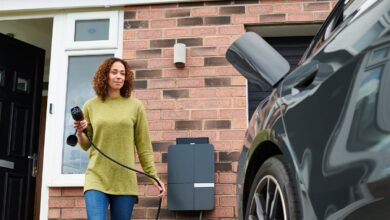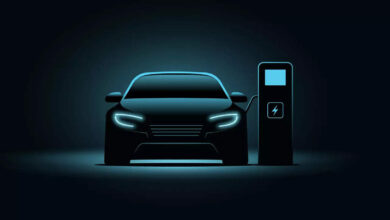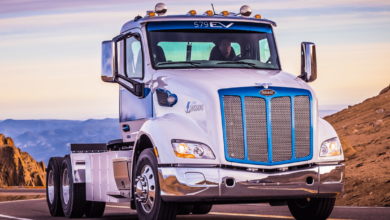This EV builder has given a Land Rover Defender four electric hub motors

BEDEO
British electric vehicle company BEDEO specializes in turning diesel vans into hybrids thanks to smart in-wheel motor tech. And its latest project—an electric Land Rover Defender conversion—could see its tech wind up on your driveway.
Land Rover’s now defunct “old” Defender is a ripe candidate for an EV restomod. There’s space for motors, batteries, and various other sundries within; in certain parts of the world, you’ll find yourself tripping over them without trying. For some reason, people go all gooey with nostalgia over them, so they don’t mind throwing money at their perfect Landie. There are plenty out there already—the UK military is looking into converting some of its fleet of Defenders into EVs, while restomod companies will sell you one upholstered with the skin of an exotic creature, and numerous others promise super silent cruising up and down the lumps and bumps of the world.
Whereas most will rip out the diesel motor and replace it with a traditional EV powertrain, BEDEO’s method is different. Rather than mounting the motor(s) on the chassis, connected to the wheels by driveshafts, the company hub-mounts them, putting a motor in each wheel, saving room elsewhere to avoid encroaching on space previously used by oily bits.
-
There’s not much to see from the outside.
BEDEO -
A peek underneath will reveal a battery box.
BEDEO -
There’s a display built into the rear view mirror that displays your state of charge and other information about the powertrain.
BEDEO -
There’s a rear-view camera, too.
BEDEO -
No one would ever accuse the Defender of having good ergonomics.
BEDEO -
Hub motors have been tried before, but they add unsprung weight.
BEDEO -
Off-road, you can feel the four motors working independently in slippery conditions.
BEDEO
BEDEO isn’t planning on selling directly to consumers, though. Instead, it will offer its solution to other businesses looking to offer electric conversions and let them give whatever level of resto-service they want. Before that happens, the company has converted its own Land Rover as a proof of concept.
The motors are from partner Protean, which has been working on hub motor tech for years. The two work together on BEDEO’s bread-and-butter business of converting existing diesel vans into hybrids—the ICE components remain in place driving the front wheels, and the rear wheels gain electric power, linked to a conveniently placed battery. Fleets can keep their existing vehicles in service and still comply with the UK’s low emissions zones. (BEDEO also offers a full EV conversion as an alternative to the hybrid upfit.) These EV and hybrid conversions have given BEDEO plenty of real-world data—over 37 million miles (60 million km) of it—and have shown how hardy Protean’s wheel motors are. Few things stress test wheels like a van driver in a hurry.
How does this system work, then? Rather than a couple of axle-mounted motors being fed by a battery, here there are four in-wheel motors and a 75 kWh battery. This combination, says BEDEO, means it weighs about the same as the ICE setup it’s replacing and is good for 153 miles on the WLTP cycle. Charging to 100 percent takes five hours on a 22 kW AC charge, or you can spec a 50 kW DC fast charge to get the job done in 90 minutes. The motors generate 320 hp (239 kW) and a staggering 1,916 lb ft (2,598 Nm), though that doesn’t mean it’s mega quick; 0–62 mph (0-100 km/h) takes 10 seconds, and the vehicle tops out at 80 mph (129 km/h).

BEDEO
On the road, it feels much like a Defender—heavy, not all that quick, and very much of its era. The controls, bar some fancy displays and a new steering wheel, are just as you’d expect from Solihull’s finest. The biggest difference is that all the squeaks and rattles that came standard from the factory can’t hide behind a clattery diesel engine anymore. There are a few regenerative braking modes to pick from, and in town, I found it was best to leave it at its strongest setting, allowing one-pedal driving. Power delivery is smooth, and though its 0–62 mph time seems a smidge glacial by modern EV standards, in this context, it feels appropriate.
For my test drive, BEDEO didn’t limit me to road driving, pointing me toward some muddy tracks with instructions to see what it could do. I’d not call the route that challenging, but it was enough to show the benefit of having four independently controlled wheels. You could feel the wheels doing different things when the going got a little slippery. The advantage of having power going to each wheel on its own is evident here—no need for big, heavy mechanical differentials, just motors talking to an electronic brain.
As a concept, it works well. The cabin and trunk don’t end up full of electronics or battery, and you can have at least 100 miles (160 km) of fun. The issue of unsprung weight will come into play for some, but it doesn’t really matter here. The car is a heavy lump already, and no one driving it will be trying to clip apexes at top speed. This might be an issue in a supercar, but in a Landie? Nah. More BEDEO kits are potentially on the way using Protean tech, but who knows what they’ll be. For now, the Defender concept works and will soon be coming to a restomodder, or maybe even a bold OEM, near you.



